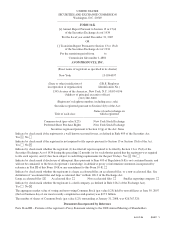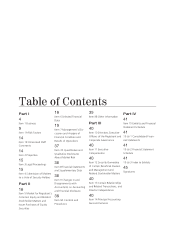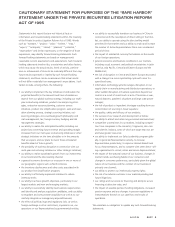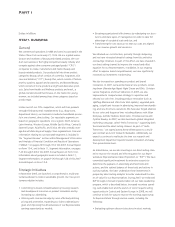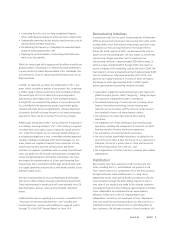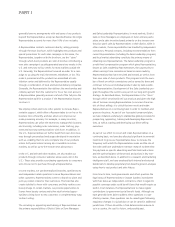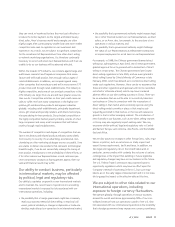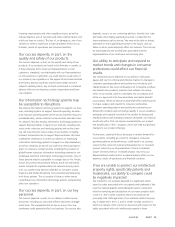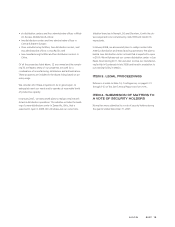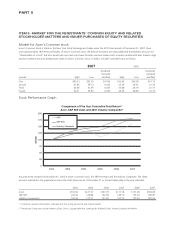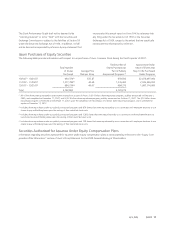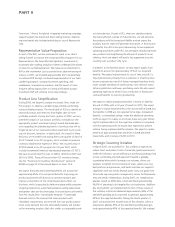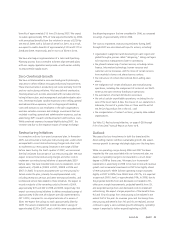Avon 2007 Annual Report Download - page 17
Download and view the complete annual report
Please find page 17 of the 2007 Avon annual report below. You can navigate through the pages in the report by either clicking on the pages listed below, or by using the keyword search tool below to find specific information within the annual report.they can invest in incentives that are the most cost effective or
produce the better payback. As the largest and oldest beauty
direct seller, Avon’s business model and strategies are often
highly sought after, particularly by smaller local and more nimble
competitors who seek to capitalize on our investment and
experience. As a result, we are subject to significant competition
for the recruitment of Representatives from other direct selling
or network marketing organizations. It is therefore continually
necessary to recruit and retain new Representatives and if we are
unable to do so our business will be adversely affected.
Within the broader CPG industry, we compete against large and
well-known cosmetics and fragrances companies that manu-
facture and sell broad product lines through various types of
retail establishments. In addition, we compete against many
other companies that manufacture and sell in more narrow CFT
product lines sold through retail establishments. This industry is
highly competitive, and some of our principal competitors in the
CPG industry are larger than we are and have greater resources
than we do. Competitive activities on their part could cause our
sales to suffer. We have many competitors in the highly com-
petitive gift and decorative products and apparel industries
globally, including retail establishments, principally department
stores, gift shops and specialty retailers, and direct-mail compa-
nies specializing in these products. Our principal competition in
the highly competitive fashion jewelry industry consists of a few
large companies and many small companies that sell fashion
jewelry through retail establishments.
The number of competitors and degree of competition that we
face in this beauty and related products industry varies widely
from country to country. If our advertising, promotional, mer-
chandising or other marketing strategies are not successful, if we
are unable to deliver new products that represent technological
breakthroughs, if we do not successfully manage the timing of
new product introductions or the profitability of these efforts, or
if for other reasons our Representatives or end customers per-
ceive competitors’ products as having greater appeal, then our
sales and financial results may suffer.
Our ability to conduct business, particularly
in international markets, may be affected
by political, legal and regulatory risks.
Our ability to capitalize on growth in new international markets
and to maintain the current level of operations in our existing
international markets is exposed to risks associated with our
international operations, including:
• the possibility that a foreign government might ban or severely
restrict our business method of direct selling, or that local civil
unrest, political instability or changes in diplomatic or trade rela-
tionships might disrupt our operations in an international market;
• the possibility that a government authority might impose legal,
tax or other financial burdens on our Representatives, as direct
sellers, or on Avon, due, for example, to the structure of our
operations in various markets; and
• the possibility that a government authority might challenge
the status of our Representatives as independent contractors
or impose employment or social taxes on our Representatives.
For example, in 1998, the Chinese government banned direct
selling but, subsequently in April 2005, the Chinese government
granted approval for us to proceed with a limited test of direct
selling in certain areas. The Chinese government later issued
direct-selling regulations in late 2005, and we were granted a
direct-selling license by China’s Ministry of Commerce in late
February 2006, which has allowed us to commence direct selling
under such regulations. However, there can be no assurance that
these and other regulations and approvals will not be rescinded,
restricted or otherwise altered, which may have a material
adverse effect on our direct selling business in China. There can
be no assurance that we will be able to successfully transition
our business in China in connection with the resumption of
direct selling in that market and successfully operate using the
direct-selling model currently in place or that may be sub-
sequently permitted in that market, or that we will experience
growth in that or other emerging markets. The introduction of
new channels in our business, such as the direct selling channel
in China, may also negatively impact existing sales. We may
encounter similar political, legal and regulatory risks in Central
and Eastern Europe, Latin America, Asia Pacific, and the Middle
East and Africa.
We are also subject to changes in other foreign laws, rules, regu-
lations or policies, such as restrictions on trade, import and
export license requirements, tariffs and taxes. In addition, we
face legal and regulatory risks in the United States and, in
particular, cannot predict with certainty the outcome of various
contingencies or the impact that pending or future legislative
and regulatory changes may have on our business in the future.
The U.S. Federal Trade Commission has proposed business
opportunity regulations which may have an effect upon the
Company’s method of operating in the U.S., but such regu-
lations are in the early stages of development and it is not possi-
ble to gauge the impact or the effective date at this time.
We are subject to other risks related to our
international operations, including
exposure to foreign currency fluctuations.
We operate globally, through operations in various locations
around the world, and derive approximately 78% of our con-
solidated revenue from our operations outside of the U.S. One
risk associated with our international operations is the possibility
that a foreign government may impose new currency remittance
A V O N 2007 11


